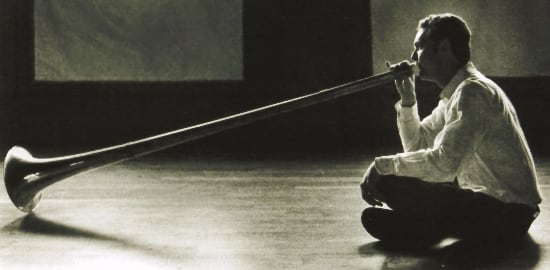Nya Kulturkvartetten

Tekst og fotos vises med godkendelse fra - stor tak til - komponisten Folke Rabe og fotografen Thord Norman.
LARS SJÖBERG on the New Culture Quartet’s CD in the Swedish evening paper Expressen, January 19, 2003:
”The only apt word is unfortunately a nowadays worn out cliché that has lost its sting: incredible. Well, which word can we use now? Anyway - a piece of extremely exhilarating entertainment at that very junction where folly and wisdom exchange tracks. And what a sound!”
CULTURE QUARTET, Contents:
1. New Culture Quartet and the Fools Trilogy
2. The New Culture Quartet, biographies
3. Stuart Dempster on the New Culture Quartet CD ”Ship of Fools”
1. New Culture Quartet and the Fools Trilogy
There was once a trombone quartet called Culture Quartet. It was formed in 1963 by Jan Bark and Folke Rabe, together with a couple of trombonist colleagues. The group performed for ten years at international festivals and concerts for contemporary music, sometimes together with Karl-Erik Andersson's Bel Canto Choir. Over the years the visual aspects of stage appearance, such as light, movement and acting, became increasingly important. Towards the end - in the early 70s - pre-recorded tapes and films were also used.
In 1982 one of our old festival contacts rang us up: the people at the Zagreb Biennale wondered if we were working on any new program. The old quartet had broken up some time ago, so we contacted a Danish musician and composer friend with whom we had had close contact since the early 60s. His name was Fuzzy. And as we were aware that the visual side of a new group would require the hand of a professional, we asked Thord Norman - who worked with filming and graphic arts - to join with us and form New Culture Quartet.
Jan Bark had gotten hold of a reprint of Sebastian Brant's versified version from 1494 of Ship of Fools, an allegory widely disseminated during the Renaissance and alluded to by many artists. A shipload of fools as a symbol of humanity. They think they are on their way to paradise, while they are actually traveling in the opposite direction. Brant claimed in his poems that the folly of mankind would lead to its self-destruction. It must be admitted that during the 500 years that have since elapsed we have come pretty far on the way to what be had predicted.
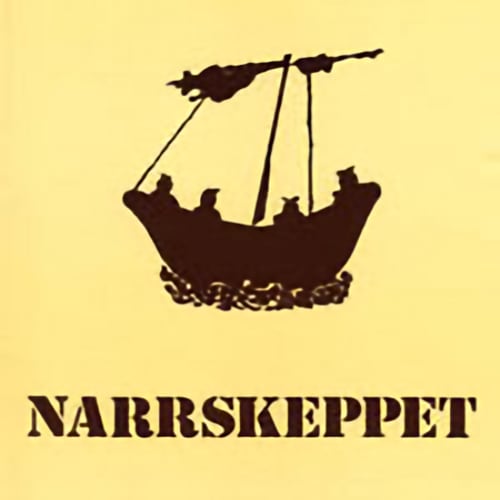
We combined Ship of Fools legend with notions of the center of the universe that have been in vogue during different periods: race, mankind, sun, earth. This resulted in the following parts:
ETHNOCENTRIC RAGTIME - OUR OWN CULTURE
GEOCENTRIC ELEGY - THE EARTH
HELIOCENTRIC TARANTELLA - THE SUN
ANTHROPOCENTRIC EUPHORIA - MANKIND
With these thematic impulses as a point of departure we collectively worked out a synopsis which, however, relates rather freely to the original ideas. At the same time the outline was concretized in music to be played live on both conventional and specially designed instruments. Also included were pre-recorded music on tape, film sequences, multislide presentations, light-and-shadow play, stage sets and theatrical acting.
The intermedia show Ship of Fools that took form had a duration of slightly more than an hour and was largely enacted in the dark. We thought this accorded well with the medieval and not entirely optimistic themes of the piece. The darkness was of course also a condition for the projections and shadow play. Incidentally, we prefer the term "intermedia" rather than "multimedia”, as we want to emphasize the interplay between the various means of expression. It is not a matter of simply piling up sensory impressions.
After a couple of final rehearsals in Stockholm open to the public we set out on tour in 1983 for the Zagreb Biennale and Austria. Ship of Fools has since then - up until the summer of 1997 (when New Culture Quartet discontinued its activities) - been performed a total of 56 times in Sweden/Scandinavia, Latvia, Poland, Germany, the USA and Canada. Altogether the quartet appeared in public 75 times.
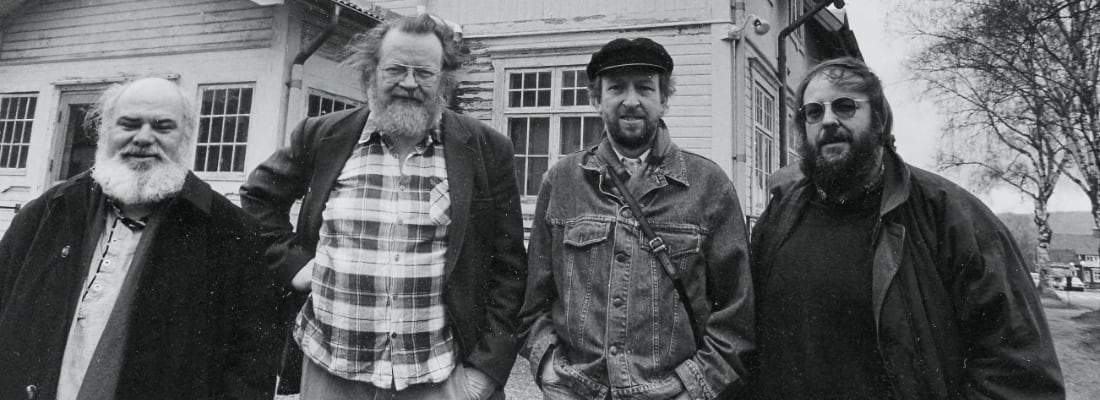
Nya Kulturkvartetten i Leksand, Sverige
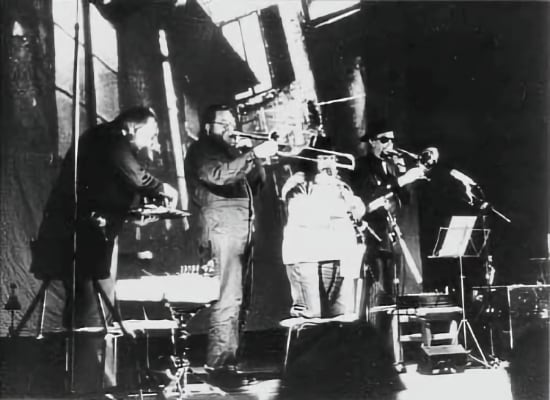
Performing Ship of Fools at the Warsaw Autumn Festival in 1984

Performing Ship of Fools at the Warsaw Autumn Festival in 1984
In the middle of the 1980s we produced, in collaboration with the Swedish Television, Channel 1, a TV version of Ship of Fools. It was not feasible for us to just use a "filming" of the stage production. The dark pictures would have been of unbearably poor quality on the TV screen, while it would also have been an uneconomical use of the television medium's possibilities of creating fantasy - e.g. moving between totally different settings. The TV version was broadcast for the first time in Sweden on 14 February 1986.
Already at an early stage we were thinking of expanding Ship of Fools into a Fools Trilogy by adding two more parts. The second part, “The World Museum” (premiered at the Nordlyd Festival in Oslo on 31 March 1987), is a dream play in which the fools experience a series of disasters, about which there had been forebodings already on the Ship. Towards the end of this second part they go through the present into a new dimension, which is at the same time a transition over to the final part of the trilogy. This last part, “Narragonia”, is the fool's paradise and the final destination of the journey (premiered at the electronic music festival in Skinnskatteberg on 2 June 1990).
From a musical point of view, Narragonia is the most integrated of the three parts. Basically it consists of a series of contrapuntally intricate variations on the old La Folia theme. The transition to the Narragonian state is marked on several levels by successive processes of inversion. Musically this occurs in the section called "The Hub", where the lower parts very gradually become the upper parts and vice versa. If this is Narragonia or our ordinary old world that in reality is topsy-turvy or inside-out - that, however, remains an open question.
One of the artists who have given pictorial form to Ship of Fools legend is Hieronymus Bosch (c. 1450-1516). The painting by him usually called Cure of Folly plays an important role in Narragonia. There are differing opinions as to what kind of situation the picture actually shows. There are some interpreters who claim that the painting symbolically depicts an act of castration. More generally, however, it is understood to be a perforation of the skull with a trepan, an operation through which "the stone of folly” is removed from the head.

Hieronymus Bosch: "Cure of Folly"

Thord Norman's version of "Cure of Folly"
The Fools Trilogy is thus composed collectively. Many people ask how we go about such work. We usually had a number of meetings where we together discussed a synopsis of the entire work on the basis of sketches produced in text/chart form with parameters such as Stage happening, Sound, Picture, etc. Then we assigned homework among ourselves, returning to the next meeting with notes, sound examples on tape, images, film sequences, props or instrument constructions; and then all this was put together gradually.
The work on the sound in the studio could either be carried out individually or with two or three together. In the latter case the positions we took on questions regarding timing were often very interesting and stimulating. In sections of Ship of Fools it sometimes happened that three of us contributed each his own layer to the same sound sequence, which was then blended to form a collectively composed unity. This was the case with the introductory "Excentric Prolog", but with other sections as well. In the latter parts of the trilogy often one of us (usually Jan Bark - but also Fuzzy) bore the main responsibility for the composition of certain musical sections. This was mostly because we were pressed for time. Composing collectively is rewarding but time-consuming. We all participated, however, in the working out of the form as a whole, and this was also the case with the Quartet's final production, Fyrbåk (premiered in Arvika on 18 March 1996). Here Jan Bark has composed all the music, while Thord Norman was responsible for the visual parts.
Udover at arbejde og spille sammen var en glæderne at opfinde og endda benytte instrumenter vi havde udviklet sammen. Det foregik ofte kollektivt og var både sjovt og inspirerende.
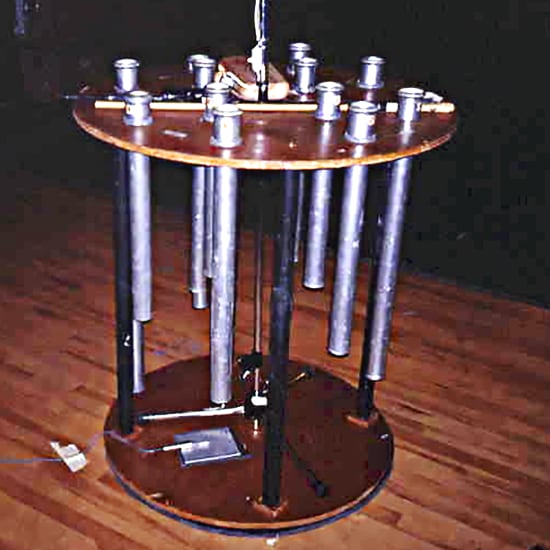
GÜNTEN Bestod af plastikrør af forskellig længde. De var stemte i nogle bestemte tonehøjder og lyden herfra blev frembragt ved at man slog på røret med indersiden af hånden.
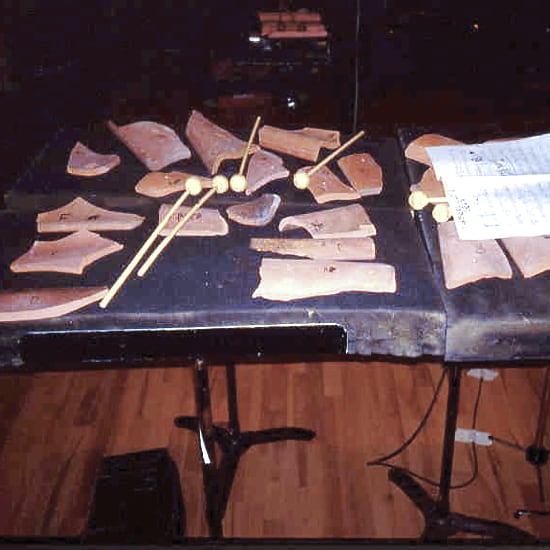
TEGELSPELET var en slags marimba af “semte” teglsten, som vi spillede på med almindelige marimbakøller. Det var Jan der fandt og stemte teglstenene ved forsigtigt gradvist at hugge småbidder af stenene indtil de frembragte den rigtige tone.
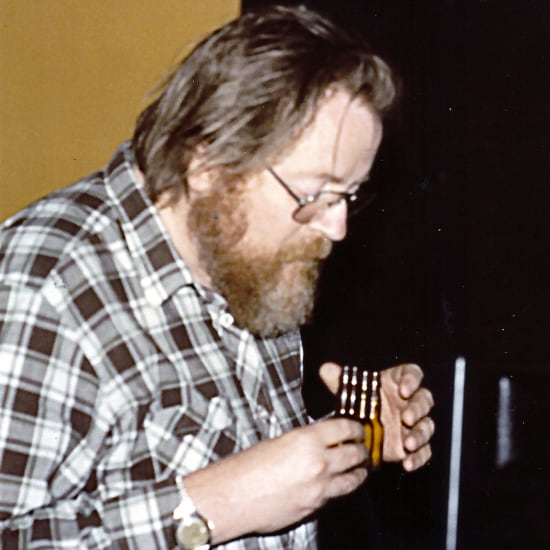
Et vigtigt instrument var panfløjter konstrueret af sammenklistrede Underbergflasker, som vi fyldte op med vand af forskellig mængde. Det tog umådelig lang tid at stemme dem.
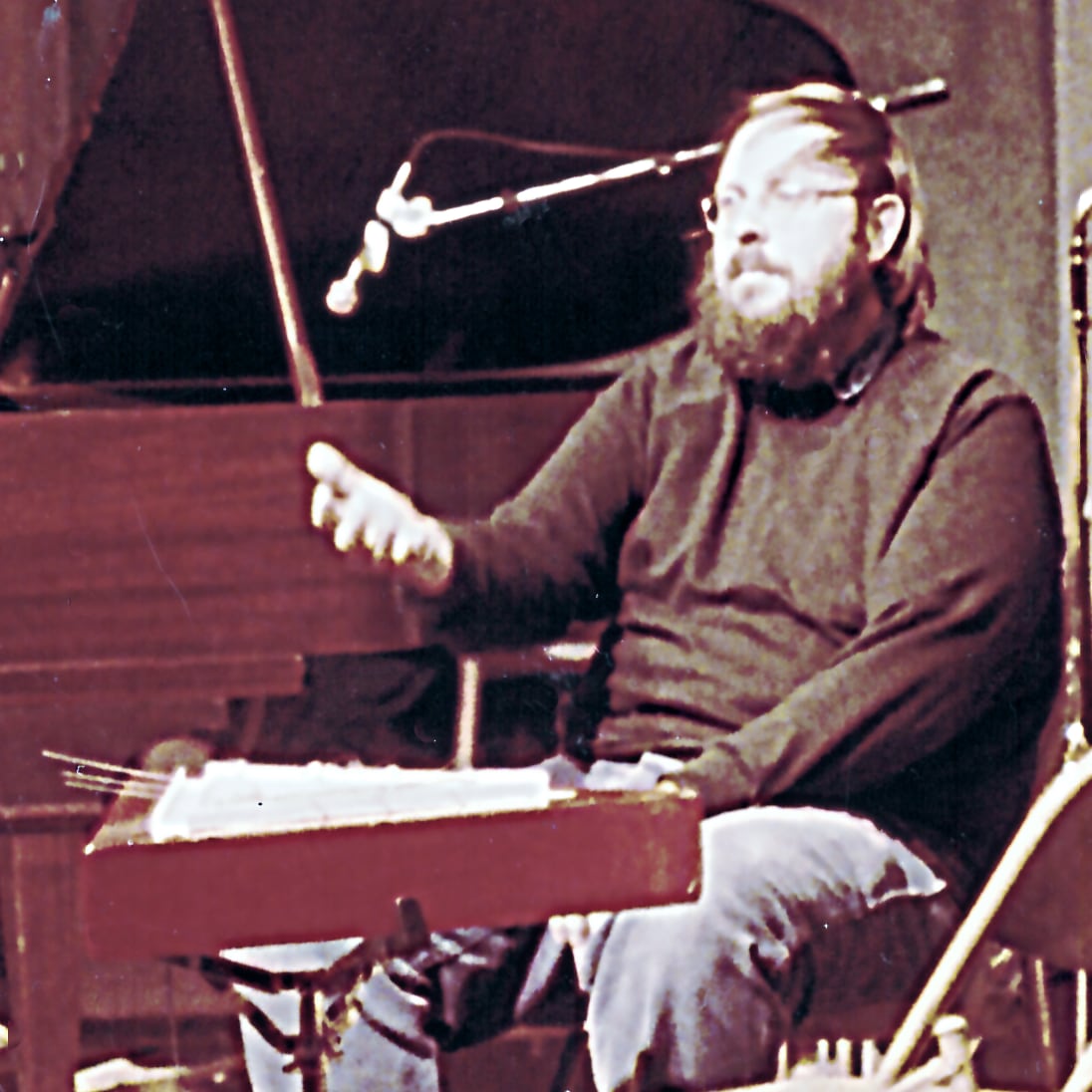
Den store Sanza havde vi fået bygget, dens relativt svage lyd blev forstærket ved hjælp af kontaktmikrofoner.
Yet another collective composition by New Culture Quartet can be mentioned: "Important or Unimportant - Does it Make Any Difference?" This was a radio concert open to the public that was commissioned by the Swedish Broadcasting Corporation, Channel 2, a live performance in the Contemporary Music Series. The concert took place on 15 May 1986.
Of course it is not possible to convey anything like an intermedia performance over to other media without something being lost. When we decided to document the Fools Trilogy on CD*) we naturally chose above all those parts that we think can stand alone as pure music, but even these in several cases have had to be shortened or adapted. We have tried as best we could to retain the titles or provisional headings of the sections, even though they are now dislodged from their original contexts.

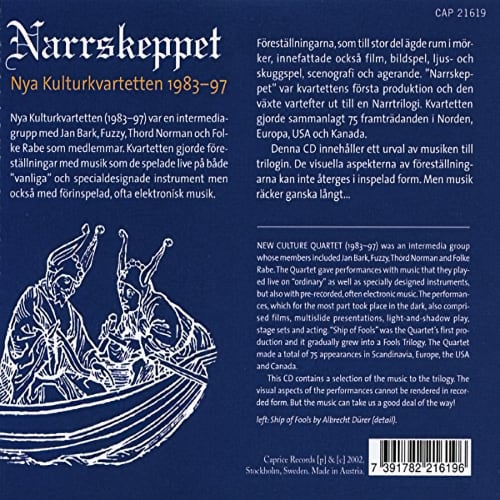
New Culture Quartet's CD on the Caprice label, CAP 21619. L to R: T Norman, Fuzzy, J Bark, F Rabe.
Culture Quartet's and New Culture Quartet's performances were often regarded as disrespectful, provocative, comical and possibly anarchist, perhaps because we have never learned to make any sharp distinction between seriousness and fun. In a panel discussion with young composers on a radio program as early as 1960 the central artistic issues of the time were debated: the composer's demand for truth in his art versus accessibility to the audience. The only one who had a different angle was Jan Bark:
"I think there is a horrible gulf between so-called entertainment music - the kind of music that is of really vital importance in our time for an awful lot of people - and the difficult, serious music; especially the modern sort. There is a colossal gulf between the two. There is almost no music there at all. There is only a great mass of people who want music. And it would be fun to try to do something in this area. It doesn't have to be a music that is free from problems. It can be full of nuances. Just because a music is easy to understand doesn't mean that it is necessarily free from problems."
And this is the music that Jan Bark has been searching for his whole life, and New Culture Quartet is one result of that search.
By Folke Rabe and the New Culture Quartet
*) Available on Caprice CAP 21619.
STAGE CHARACTERS IN SHIP OF FOOLS

THE BUTLER (Thord Norman)

THE DIVER (Jan Bark)
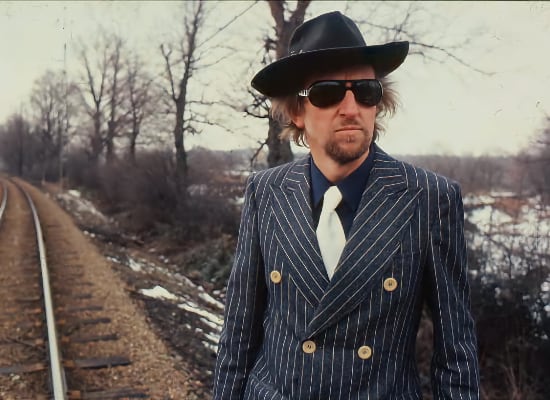
THE GAMBLER (Folke Rabe)

DER WANDERER (Fuzzy)
2. New Culture Quartet, biographies
Jan Bark (1934 - 2012):
Started out as a jazz musician in the 1940s, first played the piano, later the trombone. From 1955 studies at the State Academy of Music in Stockholm, composition with Lars-Erik Larsson, Karl-Birger Blomdahl and György Ligeti. Later studied with Edgard Varèse in New York City. Among Bark's works for the concert hall from the 1950s and 60s are a Piano Sonata, String Quartet No. 1, Pyknos for orchestra and Missa Bassa for orchestra with seven conductors, six of whom have singing parts. He has also composed the choral works Nota and Light Music, as well as the theater production Toothpick. Concurrently with his collective composing in Culture Quartet Bark made over 50 films. Many of these were joint productions with Swedish and German Television, and all of them have connections to music. The first film is "Spindrift" (1966) and the last "Ship of Fools" (1986) with New Culture Quartet. Bark has also lectured on the art of using sound at, among other places, the Swedish Television's personnel training center. From 1973 to 1999 he was head of the Film Workshop in Stockholm, a foundation that aims to support independent film-makers.
Fuzzy (Jens Wilhelm Pedersen) (b 1939):
Started early to play jazz on the clarinet and piano. From 1959 studies at the Royal Danish Music Conservatory and the Jutland Music Conservatory in Aarhus, where he studied composition with Per Nørgård. He later studied with Jan Bark, György Ligeti and Karlheinz Stockhausen. From 1966 to 1982 Fuzzy was an associate professor at the Jutland Music Conservatory. From 1982 he has been a freelance composer with an extensive production of music for ballets, theatrical plays, films and the concert hall. Since the 1960s he has worked continuously with electro-acoustic music. He has a well-equipped studio in Copenhagen where a lot of material for New Culture Quartet has also been produced. In addition Fuzzy has been very active on Danish Television. Among other things, he has had his own show called “Fuzzy's Workshop", which dealt with "music that is different" and music from other cultures. More recently his musical production has increasingly focused on instrumental and vocal music, as well as mixed forms in which acoustic and electro-acoustic elements are combined. A number of his works have won prizes. In his native country Fuzzy is a popular and well-known person whom people often stop on the street just to exchange a few words.
Thord Norman (b 1949):
Film-maker, photographer, drawer of sketches, graphic artist. He studied at the Swedish State School of Arts and the Swedish University College of Film, Radio, Television and Theater in Stockholm during the 1970s and 80s. He has worked with short films and experimental films for the Swedish Television, the Swedish Film Institute and the Film Workshop, often in collaboration with Jan Bark, as e.g. in “Penguins Cry in Minor Sea". The film "Images of Tenses" is based on music by Morton Subotnick. Norman has had his own exhibitions with photographs, graphic works and drawings at museums and galleries. In New Culture Quartet he has mainly been responsible for films, multislide presentations, projections and lighting in the Quartet's productions.
Folke Rabe (1935 - 2017):
Started out as a jazz trombonist, periodically active as a professional musician in big bands and small orchestras as well as working in studios. From 1957 studies at the State Academy of Music in Stockholm, composition with Karl-Birger Blomdahl, Ingvar Lidholm, György Ligeti and Witold Lutoslawski. He attended the Darmstadt courses on three occasions. His travels in Europe and North and South America have also given him strong impressions. Rabe's catalog of works comprises choral pieces, electro-acoustic music and from later years chamber music as well as a number of solo concertos for brass instruments. He worked 1964-68 as an assistant and technician at the State Academy of Music in Stockholm and 1968-80 as a producer, artistic leader and program director at the Swedish Concert Institute. From 1980 to 2000 Rabe held various positions at the Swedish Broadcasting Corporation.
Texts from the Caprice CD booklet. Translation: Robert Carroll.
3. Stuart Dempster on the New Culture Quartet CD ”Ship of Fools”
When I witnessed the New Culture Quartet in 1986 ("Ship of Fools", Houston, Texas) the pure musicality, let alone the astonishing visuals, were potent and strong evidence of a sound artistic endeavor. "Narrskeppet" offers prime evidence of NCQ's sheer delicacy, energetic rhythms, and outright exuberance, along with an elegant blend of humor and seriousness, that shine unpretentiously through this beautifully produced compact disc.
Stuart Dempster
Professor Emeritus
Composer/Performer/Author
Founding member, Deep Listening Band
